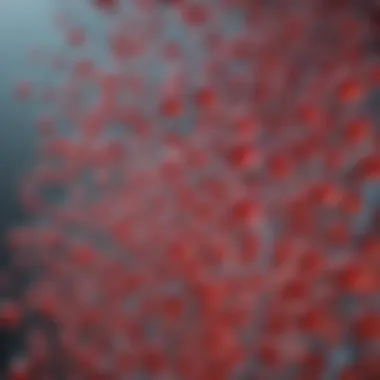Exploring Nef in HIV: Structure, Function, and Therapy


Intro
The nef gene is a critical component of the Human Immunodeficiency Virus (HIV), playing multifaceted roles in the virus's life cycle and its interactions with the host immune system. Understanding Nef is essential for researchers and healthcare professionals alike, as it offers insights into viral pathogenesis and potential therapeutic strategies. The intricate structure of Nef and its functions in immune evasion are remarkable areas of study, revealing how HIV persists in the host despite immune responses. Through this article, we will delve into the complex interplay between Nef's structural characteristics, its biological roles, and the implications for future therapeutic developments.
Methodologies
Description of Research Techniques
Several methodologies are employed to investigate the nef gene's structure and function. Scientists primarily use techniques like X-ray crystallography, which allows the visualization of Nef at the atomic level. This helps in understanding how structural variations affect its interactions with host cell components. Molecular modeling offers insights into potential conformational changes Nef undergoes during these interactions.
Additionally, biophysical methods such as circular dichroism and nuclear magnetic resonance (NMR) spectroscopy provide data on the secondary structure and dynamics of Nef. These methods confirm the structural integrity and stability of Nef, essential for its functionality.
Tools and Technologies Used
To study the nef gene, various advanced tools and technologies are utilized:
- CRISPR/Cas9: This gene-editing technology is increasingly used to create targeted mutations within the nef gene, allowing researchers to evaluate its effects on viral replication.
- Protein Purification: High-performance liquid chromatography (HPLC) is often employed to purify Nef for further experiments.
- Flow Cytometry: This technique enables the study of Nef's effects on host cell signaling pathways by analyzing cell surface markers.
Discussion
Comparison with Previous Research
Recent studies on Nef have reaffirmed many findings from earlier research while also challenging some established notions. For instance, earlier studies suggested that Nef primarily functions to downregulate CD4 and major histocompatibility complex class I molecules, facilitating immune evasion. However, contemporary research highlights its broader role in modulating various intracellular pathways, indicating a more sophisticated interplay between Nef and the host's immune defenses.
Theoretical Implications
The advancements in understanding Nef have profound theoretical implications in virology. It provides a framework for exploring how HIV adapts and evolves under selective pressure from the host immune system. Moreover, the potential of Nef as a target for novel therapeutic approaches, such as vaccines, opens new avenues in combating HIV infection. Researchers are now better equipped to devise strategies aiming directly at impairing Nef's function, presenting a promising pivot in HIV treatment options.
"Nef's ability to manipulate the host cell environment is crucial for HIV's survival and persistence within the infected individual."
Through rigorous research and analysis of the nef gene, we can gain deeper insights into the mechanisms that underpin HIV pathogenesis. This knowledge could pave the way for innovative interventions that may eventually lead to a more effective management of HIV infection.
Additionally, continued exploration into Nef's roles will likely refine our understanding of viral replication and immune evasion, ultimately contributing to the broader landscape of virology and immunology.
Prelude to HIV and Nef
Understanding the dynamics of HIV and its components is crucial for further advancements in therapeutic strategies. One integral element of HIV is the nef gene, which is known for its multifunctional role in the virus's lifecycle. This section will provide a foundational overview of HIV, setting the stage for a detailed exploration of Nef's structure and function. By unpacking the complexities surrounding these topics, the article aims to enlighten researchers and professionals about potential pathways for treatment and prevention.
Overview of HIV
HIV, or Human Immunodeficiency Virus, targets the immune system, specifically infecting CD4 T cells. The gradual loss of these critical immune cells can lead to acquired immunodeficiency syndrome (AIDS), which significantly compromises the body's ability to fight infections and diseases. HIV is primarily transmitted through bodily fluids, and while highly contagious, various factors influence its transmission rates. Both the virus's infectiousness and host susceptibility play important roles in epidemiology.
Through studying HIV, researchers have uncovered complex interactions between the virus and the host’s immune responses, providing insights into viral pathogenesis and potential intervention strategies. The understanding of how HIV infects cells and replicates is continually evolving, with ongoing research aiming to develop effective vaccines and treatments.
Significance of Nef in HIV Biology
Nef, short for negative factor, is a 27 kDa protein encoded by the nef gene of HIV. It serves multiple critical functions that contribute to the virus's ability to evade the immune response and enhance replication. The importance of Nef is underscored by its involvement in modulating the host's immune checkpoint pathways. This manipulation allows for the enhancement of viral infectivity and aids in the survival of infected cells.
One of Nef's vital roles is to downregulate CD4 receptor levels on the surface of T cells, which reduces the chance of the immune system recognizing and combating HIV. Additionally, Nef can interfere with MHC class I molecules, further evading cytotoxic T lymphocyte responses. The ability of Nef to influence signaling pathways still fascinates researchers, effortlessly showcasing the complexity of host-virus interactions.
Nef's multifaceted functions make it a prime target for therapeutic interventions. By better understanding Nef's mechanisms, researchers aim to develop strategically designed treatments that can inhibit its activity, thus restoring immune function and reducing HIV's virulence.


"The role of Nef in HIV pathogenesis underscores the intricate balance between viral evasion tactics and host defenses, presenting a compelling area for future research."
The deepening knowledge of the nef gene and its protein's actions provides a pathway for innovative therapeutic explorations. Recognizing the significance of Nef is crucial as it presents both challenges and opportunities in the ongoing battle against HIV.
Nef: Structural Characteristics
Understanding the structural characteristics of Nef is crucial for grasping its role in HIV pathogenesis. The architecture of this protein informs its function and interactions within host cellular environments. By analyzing the structure of Nef, researchers can pinpoint how it contributes to immune evasion, enhances viral replication, and affects disease progression.
Protein Structure of Nef
Nef is a small, multifunctional protein, typically composed of around 200 amino acids. Its structure is designed to facilitate various interactions with host cell machinery. The protein adopts a compact configuration, characterized by an amphipathic helix and hydrophobic regions that enable it to insert into cell membranes. This structure is key for binding with different cellular targets.
The core of Nef's function is derived from its ability to change shape. Such conformational flexibility allows it to interact effectively with several proteins, including CD4, which is essential for HIV entry into T cells. Nef also has a crucial beta-capping motif that allows it to engage with signaling pathways.
Key features of Nef structural characteristics include:
- Amphipathic properties: These allow Nef to associate with cell membranes, promoting interactions with host proteins.
- Conformational adaptability: The ability to change shape enhances functional roles, such as immune modulation.
- Epitopes: Certain parts of Nef are targets for immune recognition and therapeutics.
Through its specific structural elements, Nef can efficiently alter the function of immune cells, making it a vital contributor to HIV's pathology.
Post-Translational Modifications
Post-translational modifications (PTMs) of Nef are another critical aspect in understanding its functional capabilities. PTMs can influence protein stability, localization, and activity. Nef undergoes numerous modifications, including phosphorylation, myristoylation, and ubiquitination.
- Phosphorylation: This process regulates Nef's activity and influences its interactions with host cell signaling pathways. Phosphorylation at specific sites can alter Nef's ability to modulate immune signaling.
- Myristoylation: This lipid modification is essential for membrane anchoring, enhancing Nef's capacity to interact with lipid bilayers and cellular proteins.
- Ubiquitination: PTMs like ubiquitination play a role in protein degradation pathways, potentially affecting Nef's stability and lifespan in the host cell.
"Post-translational modifications are pivotal for regulating the functional dynamics of Nef, affecting its stability and interaction with cellular machinery."
The intricate nature of these modifications contributes significantly to the overall functionality of Nef. Researchers must consider these structural and functional attributes when exploring therapeutic strategies aimed at inhibiting Nef and undermining its role in HIV pathology.
Functional Roles of Nef in HIV Pathogenesis
The nef gene and its product, the Nef protein, play critical roles in the pathogenesis of HIV. Understanding these roles provides insights into how the virus manipulates host cells. Nef's multifaceted functions significantly affect viral replication, immune response modulation, and cell signaling pathways. These elements underline its importance as a potential target for therapeutic intervention.
Modulation of Immune Response
Nef modulates the immune response in ways that favor viral survival and replication. By downregulating CD4 receptors on the surface of infected T cells, Nef prevents the immune system from recognizing and targeting the cells harboring the virus. This process diminishes the efficacy of CD4+ T cell responses, as less CD4 on the host cell surface makes it harder for helper T cells to activate effectively. The manipulation of immune responses allows the virus to persist in the host for extended periods, complicating treatment and vaccine development efforts. This immune evasion enhances the overall pathogenicity of HIV, illustrating the need for a deeper understanding of Nef’s mechanisms.
Enhancement of Viral Replication
Nef enhances HIV replication within host cells through various pathways. One critical function is its role in facilitating the assembly and release of viral particles. By promoting the trafficking of newly formed virions to the cell surface, Nef ensures that the virus can efficiently spread to adjacent cells. Furthermore, it has been shown to influence transcriptional regulation. This means that Nef might help initiate or boost the transcription of viral genes crucial for replication, thereby increasing overall viral load in the infected individual. The enhancement of replication by Nef is a direct contributor to the progression of HIV disease, making it an essential area of focus in HIV research.
Involvement in Cell Signaling Pathways
Nef also plays a significant role in modulating cell signaling pathways. It interacts with various cellular proteins that relay signals essential for T cell activation, survival, and proliferation. For instance, Nef's interaction with proteins involved in the NF-kB signaling pathway alters cellular responses. This can lead to unregulated growth factors, further aiding the viral life cycle. Additionally, Nef affects apoptosis—a process of programmed cell death. By inhibiting apoptosis in infected cells, Nef prolongs the lifespan of these cells, allowing the virus more time to replicate and spread. Understanding these alterations in cell signaling provides important context for developing targeted therapies that may block Nef's functionality.
"The ability of Nef to modulate immune responses, enhance replication, and interfere with cell signaling illustrates its central role in HIV pathogenesis. Understanding these functions is crucial for developing effective therapeutic strategies."
Nef and Host Cell Interactions
The interactions between Nef and host cell components are crucial for understanding how HIV manages to persist and propagate within the human body. These interactions are not merely incidental; instead, they are integral to the viral lifecycle and the overarching pathogenesis of HIV. Nef exploits various mechanisms to interact with and manipulate host cell processes. This manipulation contributes to immune evasion and the enhancement of viral infectivity, thereby exacerbating the challenges faced in therapeutic development.
Nef's interactions with host cell receptors and signaling pathways help the virus subvert the immune response. By affecting how host cells recognize and respond to HIV, Nef plays a pivotal role in ensuring the virus's survival in a hostile immune landscape. This section examines the specifics of these interactions, providing insights into both their mechanisms and their biological implications.


Interactions with CD4 and MHC Molecules
Nef interacts directly with CD4 molecules on the surface of T cells, which are crucial for immune response. This interaction stems from Nef's ability to downregulate CD4 expression, thereby preventing T cells from recognizing and attacking the HIV-infected cells. By reducing the availability of CD4 on the cell surface, Nef effectively hinders the virus's recognition by CD4+ T lymphocytes.
Moreover, Nef also plays a significant role in modulating major histocompatibility complex (MHC) class I molecules. Nef can influence the expression and stability of these molecules, which are essential for presenting viral antigens to CD8+ T cells. The downregulation of MHC class I molecules results in reduced detection of infected cells by cytotoxic T lymphocytes, providing another layer of immune evasion for HIV.
- Key Points:
- Nef reduces CD4 expression to avoid immune detection.
- Downregulation of MHC class I enhances survival of infected cells.
In summary, the interaction of Nef with CD4 and MHC molecules creates a defensive barrier for HIV, allowing it to escape from the host's immune system. This intricate relationship highlights the sophistication of Nef as a viral protein that modifies host cell functions to favor viral persistence.
Influence on T Cell Activation
T cell activation is essential for an effective immune response against infections. Nef disrupts this process in multiple ways. By downregulating CD4 and altering MHC molecule expression, Nef not only decreases the activation of CD4+ T cells but also impacts the overall immune response. This has profound consequences for the body's ability to mount a defense against HIV.
Nef also engages in signaling pathways that regulate T cell activation. It can manipulate proteins involved in T cell receptor (TCR) signaling, which is vital for T cell activation and proliferation. Through these interactions, Nef can blunt the activation signals required for T cells to respond to infections effectively.
- Overall Effects of Nef on T Cell Activation:
- Impaired CD4+ T cell activation leads to reduced antiviral responses.
- Altered TCR signaling undermines the effectiveness of the immune system.
"The ability of Nef to modulate T cell activation underscores its role in ensuring HIV evades immune surveillance by affecting key cellular processes."
Conclusively, Nef's influence on T cell activation presents significant obstacles for achieving effective immune responses against HIV, reinforcing the need for innovative therapeutic approaches that can counteract these mechanisms.
Implications for Vaccines and Therapeutics
The exploration of Nef in HIV presents significant implications for vaccine development and therapeutic strategies. Understanding the multifaceted roles of Nef is crucial when aiming to enhance both vaccine efficacy and treatment. The interactions of Nef with host cell mechanisms illustrate a critical target that may lead to innovative approaches in combating HIV. Efforts to manipulate Nef could lead to potential breakthroughs in therapy and prevention strategies.
Targeting Nef in Vaccine Development
Focusing on Nef allows researchers to address a pressing need for effective HIV vaccines. Traditional vaccine strategies have faced challenges, primarily due to the virus's ability to mutate rapidly and evade immune responses. By targeting Nef, researchers can harness its unique features to design vaccines that elicit robust immune responses. Nef is a highly conserved protein among different HIV strains, suggesting that a vaccine targeting Nef could provide broader protection than those targeting variable regions of the virus.
Nef influences various immunological pathways, making it a suitable candidate for vaccine designs. Potential approaches include the use of peptide-based vaccines that stimulate cytotoxic T lymphocytes, which are critical for controlling HIV. Additionally, viral vector platforms, such as modified vesicular stomatitis virus or adenoviruses, can be used to express Nef, optimizing the immune response.
Key benefits of targeting Nef in vaccine development include:
- Cross-Protection: A conserved target increases the likelihood of a successful immune response against diverse HIV strains.
- Engagement of Multiple Immune Arms: Nef can activate both humoral and cellular immunity, enhancing the overall effectiveness of the vaccine.
- Reducing Viral Load: Effective vaccines could help in reducing the viral load during early infection phases, limiting transmission rates.
Nef Inhibitors: A Potential Therapeutic Strategy
The development of Nef inhibitors emerges as a promising therapeutic strategy in HIV treatment. By disrupting the functions of Nef, these inhibitors could inhibit viral replication and enhance immune responses against HIV-infected cells. Various compounds that target Nef's functional capabilities are undergoing exploration.
Inhibitors may work by blocking the critical interactions that Nef has with other cellular proteins. This disruption can result in a compromised ability of the virus to evade the immune system. Research into small molecules that hinder Nef's function is actively ongoing, and early results show promise.
Considerations for developing Nef inhibitors include:
- Selective Targeting: Ensuring that inhibitors specifically target Nef without affecting other host cellular functions is crucial.
- Potential for Combination Therapy: Pairing Nef inhibitors with existing antiviral treatments could yield synergistic effects, improving overall outcomes.
- Resistance Avoidance: Continuous monitoring for potential resistance mutations is important as with any antiviral treatment.
Recent Advances in Nef Research


Recent advances in Nef research mark a significant shift in our understanding of the protein's multifaceted role in HIV infection and pathogenesis. As Nef continues to be a focal point in HIV studies, its implications extend into therapeutic strategies and potential vaccine development. The body of research surrounding Nef has expanded, revealing new dimensions of its functionality and interaction with host cellular mechanisms. This space offers great promise for addressing the challenges in current HIV treatments and prevention methods.
Research indicates that Nef not only acts to enhance viral replication but also plays a crucial role in immune modulation. Understanding these dynamics allows researchers to better appreciate how HIV persists in the host despite an effective immune response. The growing insights into Nef's function pave the way for innovative approaches to combat HIV infection.
"The significance of Nef in HIV biology cannot be overstated, as it intricately influences the interplay between the virus and the host's immune system."
New Discoveries in Nef Functionality
Emerging findings reveal that Nef's functionality extends beyond its known interactions with CD4 and major histocompatibility complex (MHC) molecules. Studies have shown that Nef can manipulate various cellular pathways, activating signaling cascades that facilitate viral replication. For instance, the activation of the Src homology 2 domain-containing protein-tyrosine phosphatase (SHP-1) has been linked to Nef's ability to promote T cell activation, thereby enhancing its replicative capacity.
Additional studies have suggested that Nef influences the endosomal trafficking of cellular proteins, thereby impacting the overall immune response. This highlights the complexities behind Nef’s role, showcasing its adaptability in evading host defenses and ensuring viral fitness.
Technological Progress in Study of Nef
Recent technological advancements have significantly enhanced the study of Nef. High-resolution structural techniques, like X-ray crystallography and cryo-electron microscopy, have provided a clearer picture of Nef’s conformation and binding interactions. This has facilitated discoveries about its mechanisms of action at atomic detail, which was previously unexplored.
Moreover, novel molecular imaging techniques allow researchers to observe Nef within live cells. This real-time observation unveils insights into how Nef modulates its interactions with host cell proteins and environment dynamically. This technological progress is crucial, as it opens new avenues for designing targeted therapies that can effectively disrupt Nef's functioning in HIV-infected cells.
Future Directions in Nef Research
The study of Nef in HIV continues to be a focus for researchers worldwide. This section discusses the future directions of research surrounding Nef, emphasizing the significance of finding new therapeutic targets and exploring Nef's role in other pathogens. Each of these directions can lead to breakthroughs in treatment strategies and enhance our understanding of viral mechanisms.
Identifying New Therapeutic Targets
Identifying new therapeutic targets within the Nef protein may open up new avenues for intervention in HIV treatment. As researchers uncover the molecular mechanisms behind Nef's role in immune evasion and viral replication, they can potentially discover specific sites for therapeutic intervention. This could involve:
- Targeting protein interaction sites: Understanding how Nef interacts with host cell proteins can provide insights into how to disrupt these interactions.
- Developing small molecules or peptides: These could inhibit Nef function, leading to decreased viral replication and increased immune response efficiency.
- Utilizing novel drug delivery systems: A focused approach to drug delivery, possibly using nanotechnology, could enhance the efficacy of Nef-targeted therapies.
The exploration of these targets is essential not only for treating HIV but also for improving overall patient outcomes. By narrowing down potential targets, researchers can streamline the development of therapies that are both impactful and efficient.
Exploring Nef's Role in Other Pathogens
While Nef is primarily associated with HIV, its study may extend to its potential roles in other pathogens. Research has suggested that similar mechanisms of immune evasion might be present in various viruses. The investigation into Nef's function across different viral infections can reveal critical biological insights. This could involve:
- Comparative studies: Analyzing Nef homologs in other viruses may highlight conserved functions and novel pathways of immune evasion.
- Understanding cross-species interactions: Exploring how Nef-like proteins interact with different host organisms could yield new therapeutic strategies against zoonotic diseases.
- Developing broad-spectrum antiviral therapies: Insights gained from Nef studies might contribute to treatments that are effective across multiple viral infections.
Nef's versatility and adaptability suggest that its study has potential far beyond the realm of HIV. There is a rich field of inquiry, waiting to be explored, that could significantly enhance our understanding of virus-host interactions.
Understanding the future directions in Nef research is vital to both therapeutic developments and broadening our understanding of viral pathogenesis.
In summary, the future directions of Nef research hold promise for new therapeutic advances. By focusing on identifying new therapeutic targets and exploring Nef's role in other pathogens, researchers can continue to push the boundaries of knowledge in virology. The implications of these studies could lead to innovative interventions that improve treatment effectiveness and patient outcomes.
Ending
In the context of this article, the conclusion serves a crucial role in encapsulating the multifaceted exploration of the Nef protein in HIV. Nef's intricate structure and its biological functions are not mere academic points of interest. They represent a paradigm shift in understanding HIV pathogenesis and the potential for therapeutic innovations.
Summary of Key Findings
The article highlights several significant aspects concerning Nef:
- Structural Characteristics: Nef possesses unique structural elements that facilitate its interaction with host cell mechanisms.
- Functional Roles: It modulates immune responses, enhances viral replication, and plays an important part in cell signaling pathways.
- Host Interactions: The way Nef interacts with CD4 and MHC molecules provides insights into immune evasion strategies employed by HIV.
- Therapeutic Implications: Targeting Nef may offer new avenues for vaccine development and the creation of Nef inhibitors as therapeutic agents.
- Ongoing Research: Recent advances contribute to a better understanding of Nef, paving the way for future innovations.
The comprehensive analysis of Nef encapsulates both its biological importance and its potential as a therapeutic target.
Significance of Continuing Research
Further investigation into Nef is imperative. The complexities of its function in HIV present both challenges and opportunities. As researchers delve into Nef's interactions within host cells, they can uncover new therapeutic targets that may yield more effective treatment strategies. The significance of ongoing research includes:
- Identifying New Mechanisms: Understanding Nef can lead to discoveries of previously unknown pathways that HIV exploits.
- Therapeutic Development: Insights gained could result in innovative vaccines and drugs that prevent HIV from replicating or that enhance immune responses.
- Broader Implications: Research may extend beyond HIV, offering insights applicable to similar pathogens.



